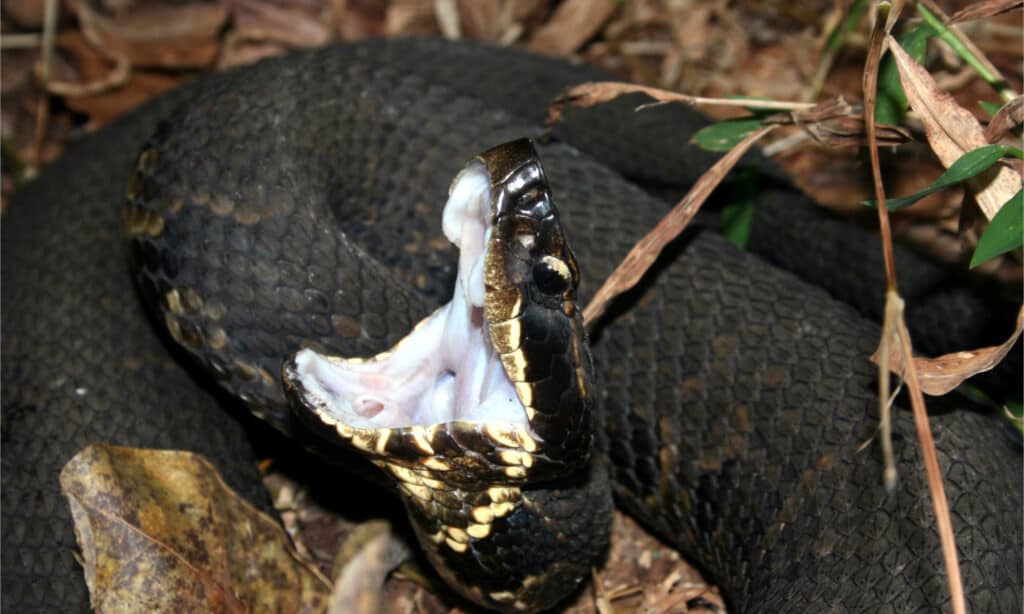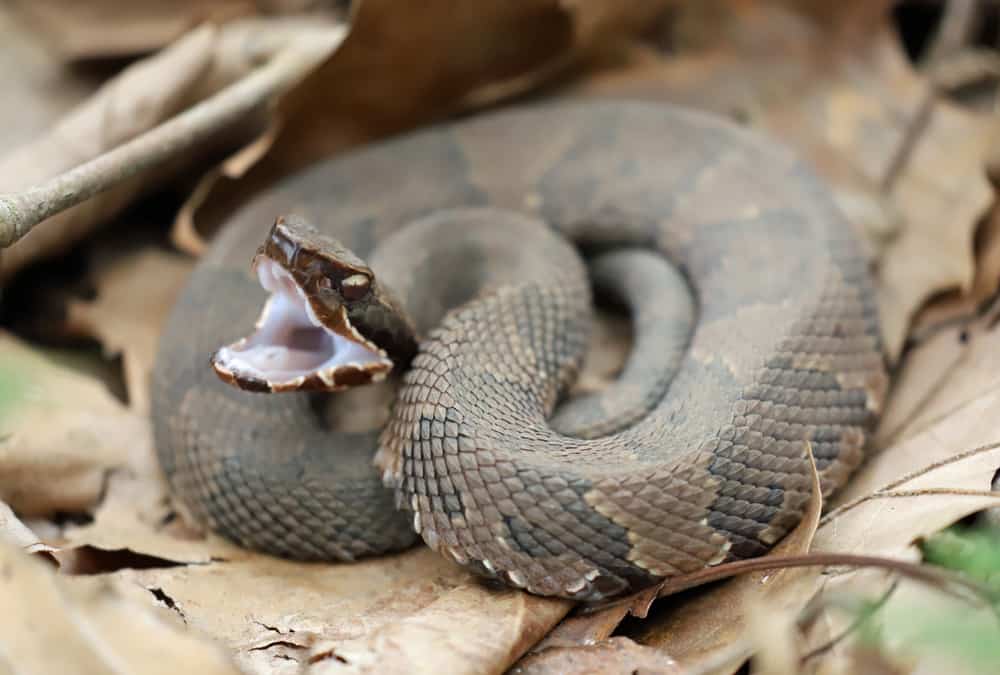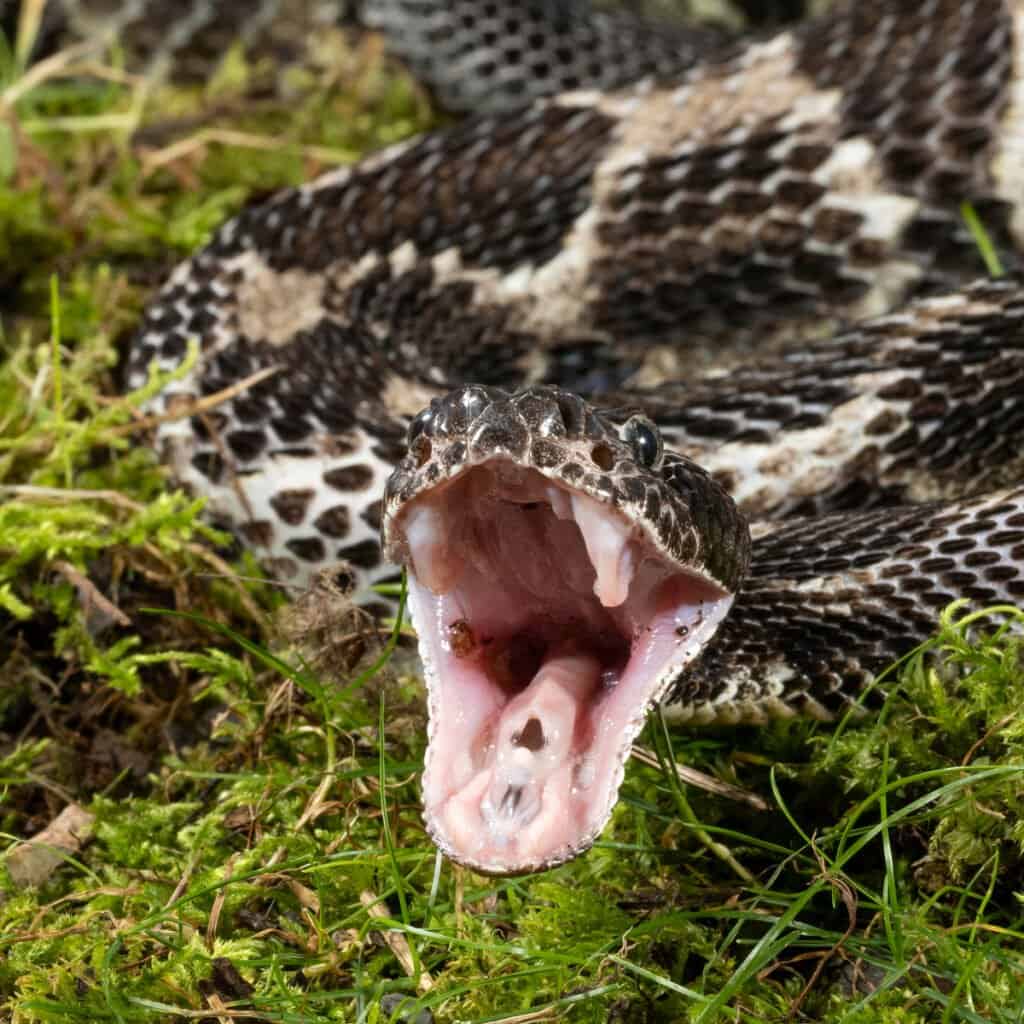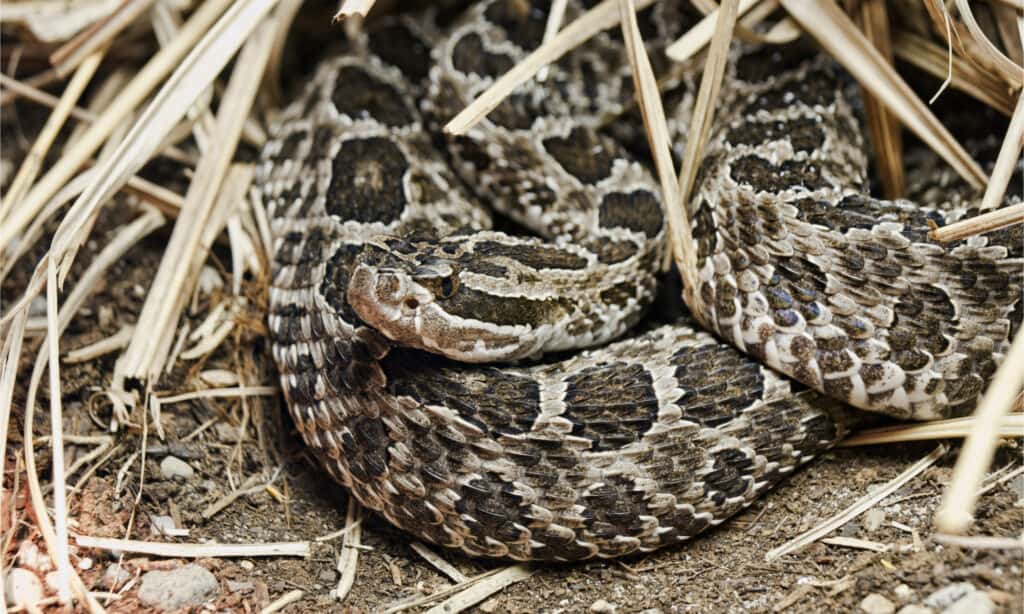Illinois is a diverse state in the Midwestern region of the United States. With farmlands, forests, and miles of rivers there are many areas for animals to thrive. Snakes are particularly abundant in the state and Illinois is home to an immense forty different species. However, out of all of these, only four of them are venomous – including the semi-aquatic cottonmouth. But just where do cottonmouths live in Illinois, and how often do they bite? Let’s find out!
What do Cottonmouths in Illinois Look Like?

Cottonmouths have a bright white color inside their mouth.
©Psychotic Nature/Shutterstock.com
Cottonmouths are semi-aquatic pit vipers that are native to the southeastern region of the United States. Historically, there were three subspecies of cottonmouths – eastern, western, and Florida cottonmouths. However, studies found that there were no distinct differences between the eastern and western subspecies and these were amalgamated into just one single species (Agkistrodon piscivorus) which was renamed the northern cottonmouth in 2014. As the Florida cottonmouth was found to be distinct from the two former subspecies it was reclassified as its own species (Agkistrodon conati). The Florida cottonmouth is native to Florida and southern Georgia.
The northern cottonmouth is the species that is found in Illinois, although there are few visual differences between the two. Cottonmouths are fairly large snakes, reaching 30 to 48 inches long. They have thick, sturdy bodies which are dark brown or black with darker crossbands and a lighter belly. Sometimes these snakes can be almost entirely black which makes the crossbands virtually indistinguishable.
Despite this, juvenile cottonmouths have a very different appearance from adults. Instead of having a dark ground color, juveniles are light brown with reddish crossbands. They are also easily distinguished by their tail which has a yellow tip.
However, the easiest way to identify a cottonmouth (although not necessarily the best), is by the bright white color of the inside of its mouth. This resembles cotton, which is why they are named cottonmouths.
Additionally, as pit vipers, cottonmouths have two heat-sensing pits which are located between their eyes and nostrils. These allow them to detect prey just by the heat from their bodies from distances of around three feet.
Where do Cottonmouths Live in Illinois?
Cottonmouths are known for being one of only a few semi-aquatic pit vipers, and they thrive in and around water. In fact, cottonmouths can be found in any freshwater habitat – such as swamps, streams, rivers, and even in ditches.
As they are often found in wetland habitats, cottonmouths have earned themselves the nickname “water moccasin”. There are several different water snakes that have a similar appearance to the cottonmouth – such as the northern water snake. It is easy for the two to be confused, but unfortunately, sometimes the harmless water snake is killed due to this misidentification.
However, you don’t need to fear cottonmouths across the entire state of Illinois as they are only found in the southernmost counties. They were once more abundant in the state than they are now, but the clearing of swampland has caused their range to become more limited.
Additionally, cottonmouths are only active between spring and fall as they spend the cold winter months brumating in their winter dens. However, they can still come out of their cozy den on warm winter days to drink water and bask in the sun for a while.
Cottonmouth Venom

The venom of cottonmouth is cytotoxic.
©KF2017/Shutterstock.com
The most important thing to know about cottonmouth venom is that it is cytotoxic. This means that it is powerful and destroys tissue. In fact, even though cottonmouth bites don’t always result in death, they can still cause serious health issues. Extensive scarring is a common result of a cottonmouth bite, but sometimes amputation of the affected limb is required.
Cottonmouths have a high venom yield with every bite, averaging 125mg, but the highest amount is around 237mg. A lethal dose of cottonmouth venom is estimated at 100 to 150mg for a human.
Cottonmouths: How often do they Bite in Illinois?
Now that we know how potent cottonmouth venom is, you’re probably wondering just how often they bite. There are no reliable records of cottonmouth bites in Illinois, but, despite venomous snakes having a really bad reputation, cottonmouths don’t actually bite that often. There are approximately 7,000 to 8,000 snake bites in the US every year (by venomous snakes). As a result, there are around five deaths per year, and of these cottonmouths only cause 1% of them.
When it comes to cottonmouths, the last thing they actually want to do is bite you without good reason. In fact, most bites actually occur as a result of being accidentally stood on. Under normal circumstances though, cottonmouths much prefer to flee. If they don’t get the chance to flee straight away (ie, if you’re stood between them and safety) then they will adopt a defensive posture first rather than attacking outright. This involves coiling themselves up and opening their mouth to display that signature white lining inside their mouth.
What to do if you see a Cottonmouth
No matter where you are, if you see a cottonmouth the most important thing to do is to steer clear of it. If you accidentally stumble upon one and find yourself too close then the first thing to do is not to panic or make any sudden movements as this is more likely to frighten or provoke the snake and cause it to strike at you.
Next, you need to calmly move away from the snake. By backing away you are showing that you’re not a threat as well as giving it the space to slither away to safety (or back into the water). Never attempt to pick up a cottonmouth or try to move it out of your way as this is one sure way to get yourself bitten.
Cottonmouths: What to do if you are Bitten
If you are unlucky enough to be bitten by a cottonmouth, the most important thing that you need to do is to seek medical attention immediately. Even if you don’t think that the wound is that serious, a bite inflicted by a cottonmouth can quickly worsen in a matter of hours. However, anti-venom is available, but the best way to avoid any serious complications is to have the wound treated as soon as possible.
Although it might be tempting to try and remove the venom yourself you should never attempt to do this. Also, even if the bite is painful do not put ice on it. Instead, keep the wound below the level of the heart.
Venomous Snakes in Illinois
Along with the cottonmouth, there are three other species of venomous snakes in Illinois. Let’s take a quick look at them.
Timber Rattlesnake

Timber rattlesnakes are threatened species in Illinois.
©Joe McDonald/Shutterstock.com
The timber rattlesnake is a large snake that is 36 to 60 inches long and has a dark brown appearance with darker crossband markings. It is a threatened species in Illinois and only lives in forests, forested bluffs, or near rocky outcrops in the southernmost third of the state. Timber rattlesnakes are extremely venomous, but this is somewhat balanced out by their nature. These snakes prefer to avoid confrontation and would rather flee when disturbed.
Massasauga

You can find the massasauga rattlesnake in Illinois.
©DnDavis/Shutterstock.com
An endangered snake is the massasauga rattlesnake which is only found in the northern half of the state in swamps, pastures, and prairies. Massasaugas are smaller than cottonmouths and timber rattlesnakes, reaching only 18 to 30 inches. They are grey or tan with darker brown or black blotches.
Copperhead

You can find copperheads in swamps in Illinois.
©Creeping Things/Shutterstock.com
Copperhead snakes are 20 to 37 inches long and typically a pale pinkish-tan color with darker brown crossbands. They only occur in the southern third of Illinois where they live in swamps and upland forests. Copperheads are generally regarded as having slightly weaker venom than cottonmouth.
Up Next
- Discover the 2 Types of Rattlesnakes in Illinois
- Venomous (Poisonous) Snakes in Illinois
- Discover the 10 Largest Animals in Illinois, and Where You’ll Find Them
The photo featured at the top of this post is © Psychotic Nature/Shutterstock.com
Discover the "Monster" Snake 5X Bigger than an Anaconda
Every day A-Z Animals sends out some of the most incredible facts in the world from our free newsletter. Want to discover the 10 most beautiful snakes in the world, a "snake island" where you're never more than 3 feet from danger, or a "monster" snake 5X larger than an anaconda? Then sign up right now and you'll start receiving our daily newsletter absolutely free.
Sources
- National Library of Medicine, Available here: https://www.ncbi.nlm.nih.gov/books/NBK546645/
- Centers for Disease and Control Prevention, Available here: https://www.cdc.gov/niosh/topics/snakes/default.html#:~:text=Each%20year%2C%20an%20estimated%207%2C000,than%20to%20die%20from%20them.
- Live Science, Available here: https://www.livescience.com/43597-facts-about-water-moccasin-cottonmouth-snakes.html#:~:text=%22Like%20all%20pit%20vipers%2C%20%5B,which%20is%20often%20potential%20prey.
- University of Illinois, Available here: https://herpetology.inhs.illinois.edu/species-lists/ilspecies/cottonmouth/
Thank you for reading! Have some feedback for us? Contact the AZ Animals editorial team.






